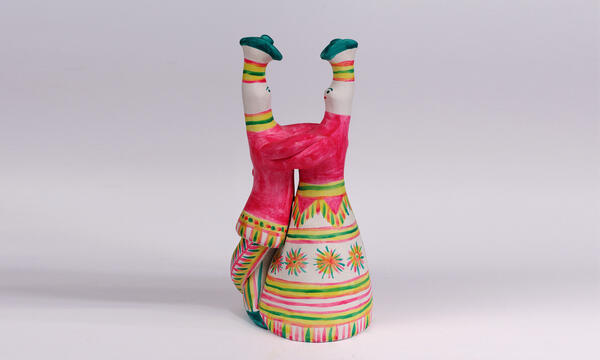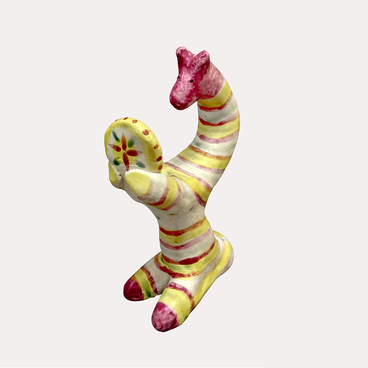The Couple toy was designed by Galina Mishina in the Filimonovo tradition. The image of lovers sharing a passionate embrace is quite common in the local craft. Such figurines are also popularly called ‘lyubota’ (love).
The Filimonovo toys usually had a simplified shape with no excessive or small details. The proportions of human bodies were elegantly elongated: the figures were distinguished by narrow waists merging into voluminous trousers or fluffy bell skirts. Heads and necks were roughly the same in width. The figurines were crowned with headwear: a scarf or a hat for ladies and a cap or a top hat for gentlemen.
The painting of Filimonovo toys is especially interesting. The reference of broken and solid lines, circles, rhombuses, triangles, stars, rosettes, and herringbones to Pagan symbolism hints at the toy’s long history. Herringbones, like on the gentleman’s trousers in this toy, meant the Tree of Life. Circles were considered talismans that protected the good from the evil. Solar signs on the skirt symbolized the sun and life itself.
The colors most used in the craft also had special meanings. In the olden times, it was believed that yellow represents the sun and air, red meant warmth and beauty, and green signified spring and life. The colors were applied strictly one by one: first, the figurine was painted with yellow wide stripes and circles over the skirts of ladies, the trousers of gentlemen, the necks and sides of animals, and the wings of birds. Then they moved on to the phase called ‘malinka’ (crimson): red or crimson paint was used to draw thin stripes, circles, dots, and other patterns on a yellow background. The painting process started from the center. The characters’ shirts were also painted red. The last stage was applying “zelyonka” (brilliant green) to the toys in green strokes.
Until 1972, the toys were fired in pottery kilns along with other items: makhotki (a low jug with a wide neck), pots, greens, chimneys and tops for Russian stoves. They were painted with paints based on a chicken egg, and most often feathers were used instead of brushes. Nowadays, craftsmen prefer muffle furnaces, where the temperature reaches up to 950 degrees, and decorate the burnt items with resistant acrylic paints. Some craftswomen work with feathers in an old-fashioned way, as well as with brushes made of natural materials.
The Filimonovo toys usually had a simplified shape with no excessive or small details. The proportions of human bodies were elegantly elongated: the figures were distinguished by narrow waists merging into voluminous trousers or fluffy bell skirts. Heads and necks were roughly the same in width. The figurines were crowned with headwear: a scarf or a hat for ladies and a cap or a top hat for gentlemen.
The painting of Filimonovo toys is especially interesting. The reference of broken and solid lines, circles, rhombuses, triangles, stars, rosettes, and herringbones to Pagan symbolism hints at the toy’s long history. Herringbones, like on the gentleman’s trousers in this toy, meant the Tree of Life. Circles were considered talismans that protected the good from the evil. Solar signs on the skirt symbolized the sun and life itself.
The colors most used in the craft also had special meanings. In the olden times, it was believed that yellow represents the sun and air, red meant warmth and beauty, and green signified spring and life. The colors were applied strictly one by one: first, the figurine was painted with yellow wide stripes and circles over the skirts of ladies, the trousers of gentlemen, the necks and sides of animals, and the wings of birds. Then they moved on to the phase called ‘malinka’ (crimson): red or crimson paint was used to draw thin stripes, circles, dots, and other patterns on a yellow background. The painting process started from the center. The characters’ shirts were also painted red. The last stage was applying “zelyonka” (brilliant green) to the toys in green strokes.
Until 1972, the toys were fired in pottery kilns along with other items: makhotki (a low jug with a wide neck), pots, greens, chimneys and tops for Russian stoves. They were painted with paints based on a chicken egg, and most often feathers were used instead of brushes. Nowadays, craftsmen prefer muffle furnaces, where the temperature reaches up to 950 degrees, and decorate the burnt items with resistant acrylic paints. Some craftswomen work with feathers in an old-fashioned way, as well as with brushes made of natural materials.


